Sheetmetal can be formed by bending or forming it over various shaped anvils known in the sheetmetal trade as stakes. These stakes vary in shape depending upon the work to be done on them. Square, round and conical work can be formed, and edges and seams can be finished on them. Stakes are used when a suitable machine is not available or when a machine is not readily adaptable to the work.
A bench plate or stake holder is used to hold the stakes while they are being used.
Stakes come in a variety of sizes and shapes. Stakes have shanks which fit into the holes in the bench plate or stake holder. The work is done on the heads or the horns of the stakes which are machined, polished and in some cases, hardened. Stakes are used for finishing many kinds of work; therefore, they should not be used to back up the work when cutting with a cold chisel.
This stake is a single horizontal metal bar. One end has a flat surface and the other end is rounded. The flat length has a slot cut in it which permits the stake to be fastened directly to the bench. This stake is used for forming, seaming or riveting. These stakes are available in various lengths and weights.
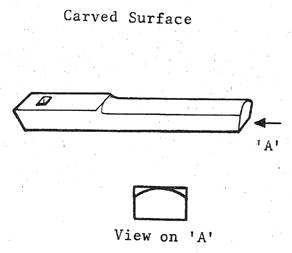
Figure 1 - Mandrel Stake
The Hatchet Stake is a sharp, straight stake with a hardened and bevelled edge. It is used for making straight sharp bends, folding, bending edges and is used as a support when flanging.
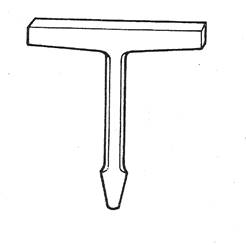
Figure 2 - Hatchet Stake
The Tinman’s Anvil has a flat, square shaped head with a short shank and is used for general working operations.
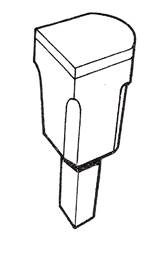
Figure 3 - Tinman's Anvil
The Pipe Stake consists of one or two cylindrical horns having different diameters. This stake is used for forming pipes and cylindrical work pieces. The stake with the two horns is called a Double Ended Pipe Stake.
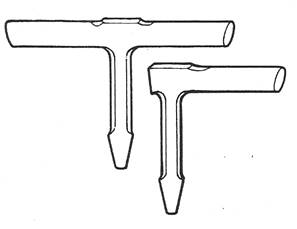
Figure 4 - Pipe Stake
The Funnel Stake has a thick tapered head and is used in forming, riveting and seaming tapered articles such as funnels.
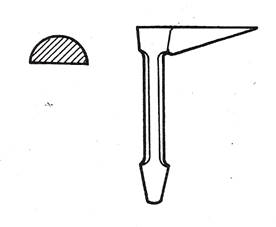
Figure 5 - Funnel Stake
The Blowhorn Stake has a short, tapered horn at one end and a long tapered horn at the other. It is used in forming, riveting and seaming abrupt and slender tapering objects.
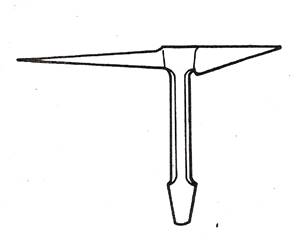
Figure 6 - Blowhorn Stake
The Half-Moon Stake consists of a single vertical shank with a half-rounded head on top. The stake is used for forming or shaping curved flanges.
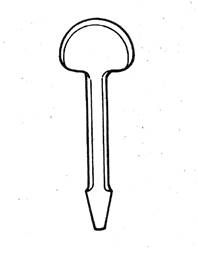
Figure 7 - Half-Moon Stake
The Bick Iron Stake has a square tapering, flat horn on one side and a round tapered horn on the other side. It serves as a general purpose anvil for riveting and shaping round and flat surfaces, straight bending and corner seams.
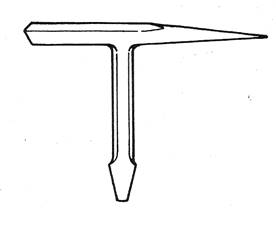
Figure 8 - Bick Iron Stake
This stake is available in two patterns. One has a double rectangular shaped horn and contains a number of grooved slots for creasing metal and bending wire; the other pattern has a round and tapered horn at one end and a rectangular shaped horn on the other and is used for forming, riveting or seaming small tapering objects.
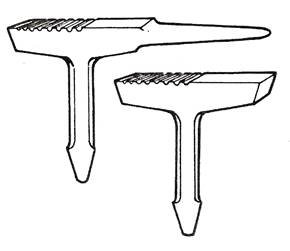
Figure 9 - Creasing Stake
This is used for finishing off knocked-up joints on small trays and boxes. They are also used for general work in the sheet metal shop.
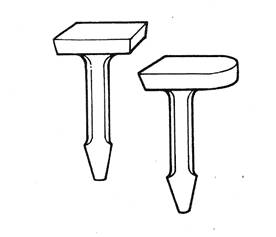
Figure 10 - Drip Pan Stakes
The Round Bottom Stake consists of a single vertical piece with a flat round head on top. It is used for flanging circular and curved work.
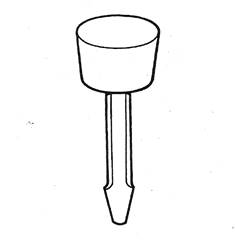
Figure 11 - Round Bottom Stake
This is used in the process of raising and planishing a hollow article.
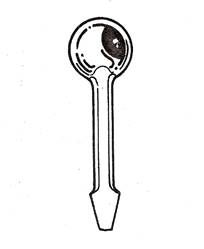
Figure 12 - Ball Head Stake
This stake has a holder (the horse part of the stake) which can take various shaped small heads. This stake is useful in many operations for which other stakes are not suitable.
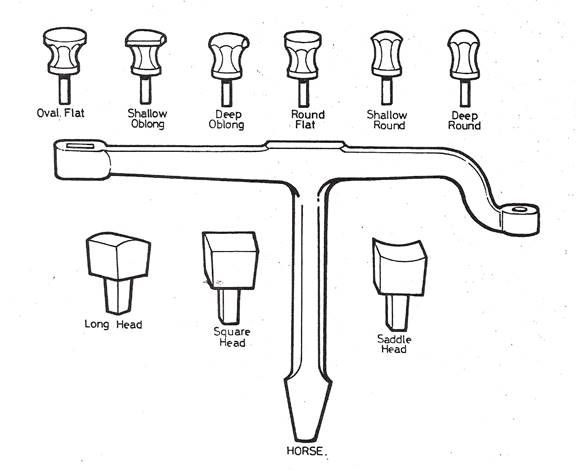
Figure 13 - Tinman's Horse with Heads
These stakes are usually found around any sheet metal shop. They are used as stakes for various purposes, depending on the nature of the work being formed.
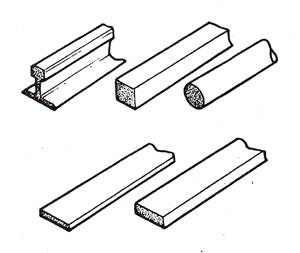
Figure 14 - Common Iron Stake
This is used for holding stakes and is secured to the bench.
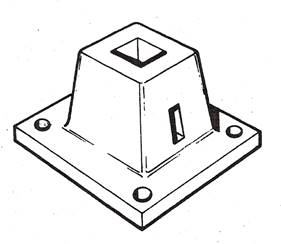
Figure 15 - Stake Holder
They are used in conjunction with the planishing hammer or cross as Pein Hammer, a support or anvil to smooth out panels, welds, kinks etc.
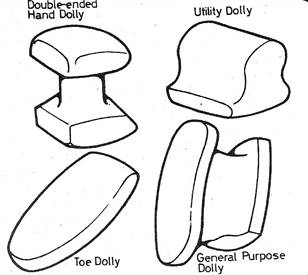
Figure 16 - Hand Dollies
One of the characteristics of the skilled worker is the way in which he selects and uses his tools. For this reason, it is essential that you know how to select and use both hand and machine tools correctly. If you do this you will save time and the work will be much easier. When you have selected the correct tool for the correct operation you have taken the first step in becoming a successful craftsman.
Sheetmetal hand tools are used to scribe or measure lines, perform layout operations and shape or cut metals. Some of the hand tools in the following notes actually perform these operations while others, such as stakes and punches, serve as aids in performing them.
It is important to keep tools in good shape. Avoid tools going rusty by giving steel tools an occasional oiling. Tools with a sharp point should be stored carefully.
This is used to mark lines on metal. It can be used in conjunction with a straight edge and square.
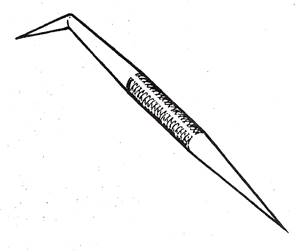
Figure 17 - Scriber
The Straight Edge is used as a guide for a scriber or pencil when marking a straight line or drawing a line between two points. It is also used in conjunction with a square to draw lines at right angles.
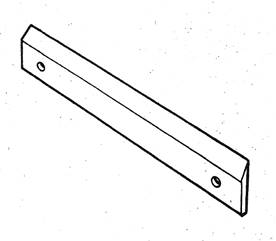
Figure 18 - Straight Edge
This is made with each straight leg tapered to a needle point. Dividers are manufactured in various sizes and types and are used to space off equal distances, to divide lines into equal parts and to scribe arcs and circles. Spring loaded screw dividers are a more accurate type.
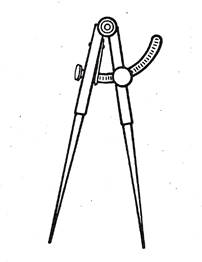
Figure 19 - Dividers
The flat Steel Square is used to layout right angles (90°) and can also be used as a scale. It is an invaluable tool for accurate layout work in pattern drafting.
The long arm is known as the body or blade, the short arm is known as the heel or tongue.
These squares come in various sizes.
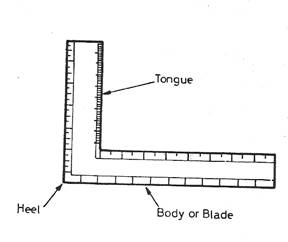
Figure 20 - Steel Square
It is used for marking and checking right angles (90°).
These squares come in various sizes.
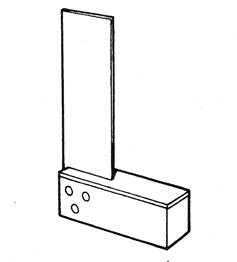
Figure 21 - Steel Try Square
This is one of the most useful and convenient tools for laying out small work. It is used as a square for measuring or laying out 90° or 45° angles.
A spirit level is mounted in the stock.
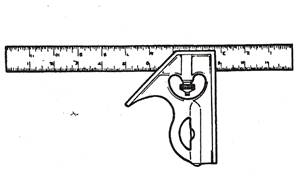
Figure 22 - Combination Square
This is a device for measuring and laying out angles from the edge of the work. This protractor consists of a head and a movable blade.
The head of the protractor has a semicircular scale graduated from zero to 180°.
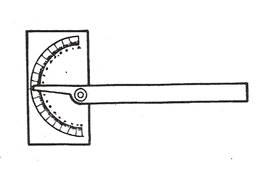
Figure 23 - Swinging Blade Protractor
These are used for scribing large arcs and circles.
They are manufactured in various types with two straight, removable legs tapered to needle points and attached to separated heads or holders.
The heads or holders slide on wood or steel beams and are held in place by thumb screws. Either of the points can be removed and often one point has adjustment for fine settings. A special clamp for a pencil can be attached to one of the points.
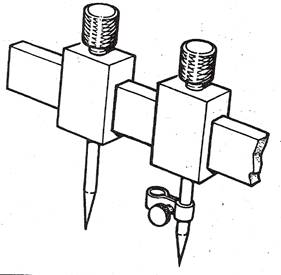
Figure 24 - Trammel Points
Rulers are manufactured in a variety of types and lengths; each of which is designed for measuring or laying out different work.
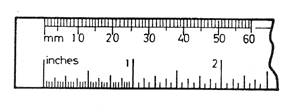
Figure 25 - Rulers
Similar in design to the prick punch except that the tapered point is ground to an angle of 90° included. They are available in various shapes and sizes and are used for locating centres for drilling etc.
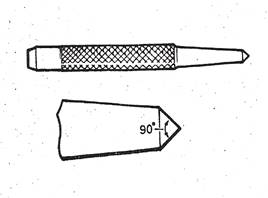
Figure 26 - Centre Punch
Solid Punches are used to punch small holes in light gauge metal. These punches can be obtained in sets of various sizes.

Figure 27 - Solid Punch
Hollow Punches are used for cutting circular holes ¼" or 6mm or larger from sheet metal. To avoid chipping the edges of the hollow punch the sheet metal should be placed over a block of lead.
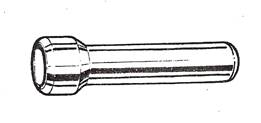
Figure 28 - Hollow Punch
This is used much like the common rule. It is invaluable for laying out patterns. It is available in metric or imperial graduations. Its length is 24" or 600mm depending on the type. The purpose of this rule is for finding the circumference of cylinders and for angular measurement.
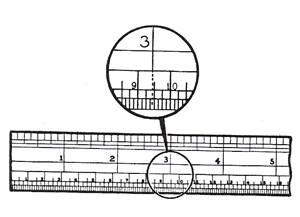
Figure 29 - Steel Circumference Rule
The length varies from 6ft to 12ft or from 2m to 3.5m. It is very popular for measuring and laying out large jobs.
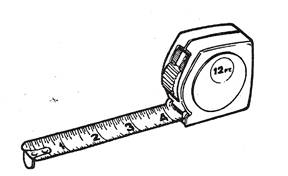
Figure 30 - Tape Rule
Prick Punches are made of tool steel and having a tapered point ground to approximately 30° included angle. These punches are used for making small dents or indentations and/or establishing points for dividers and trammel points.
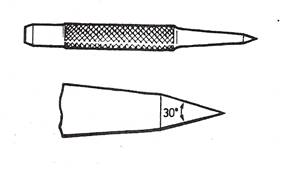
Figure 31 - Punches
The Hand Groover is used when grooving a seam by hand. The end of the tool is recessed to fit over the joint making the grooved seam. It is available in various sizes.
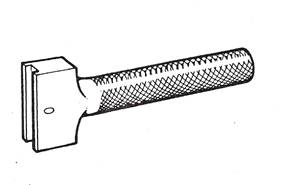
Figure 32 - Hand Groover
The Rivet Set is made of tool steel. The deep hole in the bottom is used to draw a rivet through metal. The cup-shaped hole is used to form the finished head of the rivet. The hole in the side is to release the burrs that are punched through the metal. They are available in various sizes.
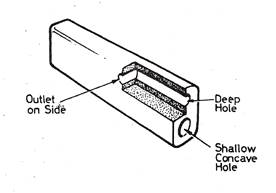
Figure 33 - Rivet Set
This chisel is used widely by the sheet metal worker. It is used mainly for cutting sheetmetal, rivets, bolts and in chipping operations.
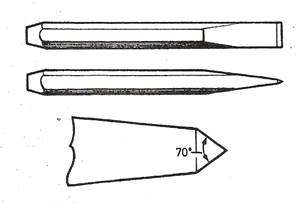
Figure 34 - Flat Cold Chisel
This is used for stretching edges and flanges on curved work. It is normally used in conjunction with a stake.
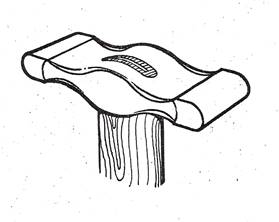
Figure 35 - Stretching Hammer
This is a shaping hammer used on mild steel in conjunction with a sandbag or wooden hollowing block, and to create a double-curved shape by hand.
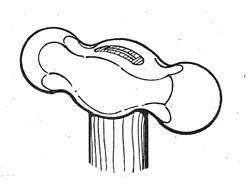
Figure 36 - Hollowing Hammer
The principal purpose of the Planishing Hammer is for smoothing and finalising a surface after it has been roughed out to the required shape.
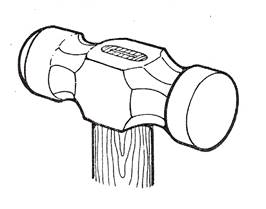
Figure 37 - Planishing Hammer
These mallets can be used on mild steel, copper or aluminium to prevent marring the metal.
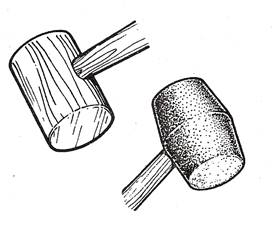
Figure 38 - Boxwood and Rubber Mallets
This mallet is used in conjunction with a sand bag or wood block for either hollowing or raising when shaping metal by hand to a double-curvature shape.
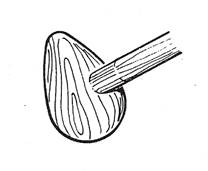
Figure 39 - Pear-Shaped Boxwood Mallet
These snips are used for straight line cutting. They are available in many different sizes.
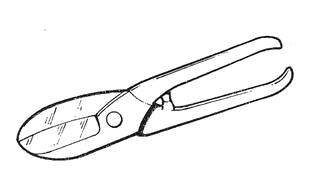
Figure 40 - Straight Snips
This is used by the sheet metal worker for riveting, peening and for general use in the sheet metal shop.
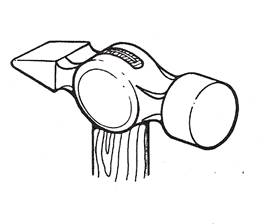
Figure 41 - Cross Pein Hammer
This is used for striking chisels, punches, rivets etc. and for general engineering use.
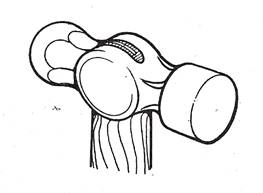
Figure 42 - Engineers Ball Pein
Vice Grips are generally used for holding objects together. It acts as a clamp when spot welding, riveting, welding etc. It is available in various sizes.
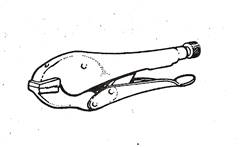
Figure 43 - Vice Grips
This is used primarily for tightening or loosening slotted screws. Screwdrivers are available in various lengths and with different types of handles e.g. wood, metal or plastic materials.
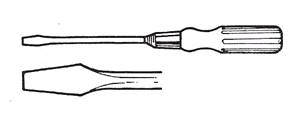
Figure 44 - Plain Screwdriver
This screwdriver has a cross-shaped tip. This fits into the head of a screw which has a recess of the same shape. This type of screwdriver will not slip and burr the end of the screw if the proper size is selected.

Figure 45 - Philips Screwdriver
The Hack Saw is used for cutting materials by hand. It consists of a renewable hardened steel saw blade fitted into an adjustable frame, which is usually provided with a screw adjustment for controlling the tension of the blade. It is necessary to have both junior and senior hack saws in your tool kit.
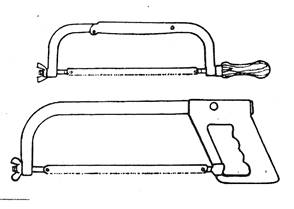
Figure 46 - Hack Saw
There are many shapes and sizes of Files available with various grades of cut.
Files are used to remove burrs from sheets of metal, to straighten uneven edges and for various other operations that require a small amount of metal to be removed. They should always be used with a handle. Common types used by the sheet metal worker are: flat, square, round, half-round.
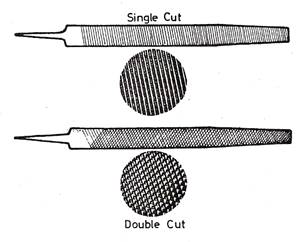
Figure 47 - Files
The Hand Lever Punch is used by the sheet metal worker for punching holes in sheet metal and button punching.
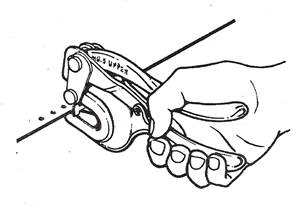
Figure 48 - Hand Lever Punch
These snips are used to cut straight and irregular lines and curves. These are the snips used most commonly by the sheet metal worker. They are available in the same sizes and capacities as straight snips and are also available for right or left hand use.
Spring loaded snips known as aviation snips are very good for notching of jobs.
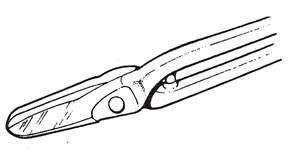
Figure 49 - Combination Snips
These pliers have flat jaws grooved to hold the work, and are sharpened to cut light wire.
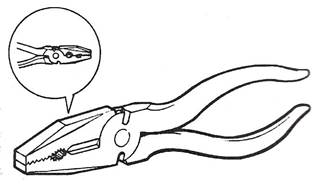
Figure 50 - Side Cutting Pliers
These are used for holding, cutting and bending work. The pliers are so constructed that the jaws can be adjusted for holding different sizes of work.
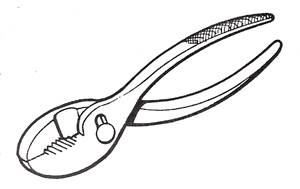
Figure 51 - Combination Pliers
Sand Bags are leather bags made from two pieces of the finest leather, filled with very fine sand and stitched together. They are available in a variety of weights and sizes but are usually round or square in shape.
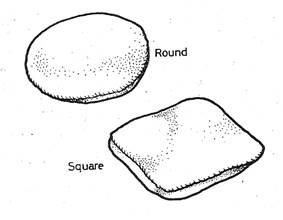
Figure 52 - Sand Bags
In some instances Hardwood Blocks are hollowed out to different depths and diameters. These blocks are used in the same manner as the sandbag for shaping metal, although the blocks are more solid and do not “give” as much as the resilient sandbags.
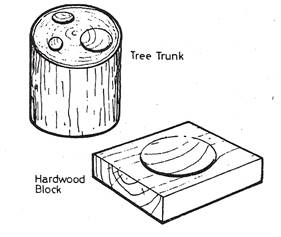
Figure 53 - Hardwood Blocks
A Soldering Iron consists of a forged piece of copper connected by an iron rod to a handle. The shape and the size of the bit varies with the type of work for which it is to be used. Electric soldering irons are also available.
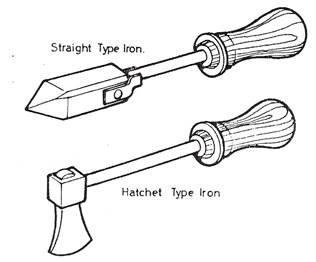
Figure 54 - Soldering Irons
“Pop” Riveting Guns are used extensively with “pop” rivets for the assembly of light fabrications and are particularly useful for the assembly of ductwork where access is restricted to one side of the work only. There are three different types available: hand “pop” gun, lazy tongs and pneumatic (air).
Riveting in confined spaces requires the use of a hand “pop” gun. These are unsuitable for larger dimensions of rivets, due to the reduced amount of leverage available.
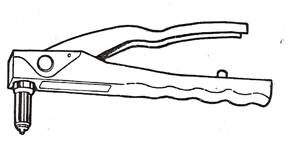
Figure 55 - Hand "Pop" Gun
Lazy Tongs are used for the larger diameters of rivets, where sufficient working space is available to permit operation of the tool.
The construction of the tool permits a moderate pressure on the handle to provide a strong pulling force on the rivet mandrel.
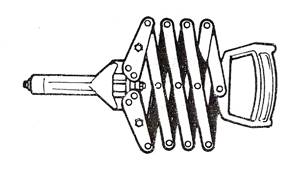
Figure 56 - Lazy Tongs
Source: http://local.ecollege.ie/Content/APPRENTICE/liu/sheetmetal_notes/Induction_M1_U1.doc
Web site to visit: http://local.ecollege.ie/
Author of the text: indicated on the source document of the above text
If you are the author of the text above and you not agree to share your knowledge for teaching, research, scholarship (for fair use as indicated in the United States copyrigh low) please send us an e-mail and we will remove your text quickly. Fair use is a limitation and exception to the exclusive right granted by copyright law to the author of a creative work. In United States copyright law, fair use is a doctrine that permits limited use of copyrighted material without acquiring permission from the rights holders. Examples of fair use include commentary, search engines, criticism, news reporting, research, teaching, library archiving and scholarship. It provides for the legal, unlicensed citation or incorporation of copyrighted material in another author's work under a four-factor balancing test. (source: http://en.wikipedia.org/wiki/Fair_use)
The information of medicine and health contained in the site are of a general nature and purpose which is purely informative and for this reason may not replace in any case, the council of a doctor or a qualified entity legally to the profession.
The texts are the property of their respective authors and we thank them for giving us the opportunity to share for free to students, teachers and users of the Web their texts will used only for illustrative educational and scientific purposes only.
All the information in our site are given for nonprofit educational purposes